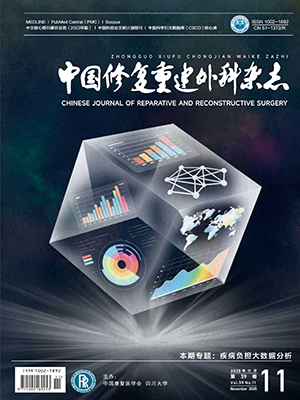Objective To explore the cl inical outcomes of repairing l imb wound with distal based neurocutaneous flap. Methods From June 2003 to June 2009, 187 cases with wounds in the hand, foot, and distal leg were treated. There were
127 males and 60 females aged 20-70 years old (average 37.5 years old). The wound was caused by traffic accident in 130 cases, crush injury in 38 cases, machinery accident in 16 cases, and explosion injury in 3 cases. Among them, the soft tissue defect was in the dorsal and palmar aspects of the hand in 35 cases, the distal leg in 50 cases, the dorsal aspect of foot in 40 cases, the region around ankle in 27 cases, the tendon area in 11 cases, the medial side of foot in 4 cases, the heel and sole of foot in 5 cases, and the forefoot area in 15 cases. The size of skin soft tissue defect was 5.0 cm × 3.0 cm-17.5 cm × 10.0 cm. Four cases suffered from nonunion of heel and 15 cases suffered from tibia defect (3-7 cm). The course of disease was 3 days-8 years. During operation, 35 cases with wound in the hand were treated with three types of lower rotation point of forearm neurocutaneous flaps with rotation points 0-3 cm above the wrist joint, 66 cases were treated with distal based saphenous nerve and saphenous vein neurovascular flaps, muscle flaps and bone flaps with rotation points 2-5 cm above the medial malleolus, and 86 cases were treated with sural and saphenous flaps, muscle flaps and bone flaps with rotation points 1-5 cm above the external malleolus. The flap was 5 cm × 3 cm-17 cm × 15 cm in size, the muscle flap was 5 cm × 3 cm × 1 cm-10 cm × 6 cm × 2 cm in size, the fibula flap was 4.0 cm × 2.5 cm-10.0 cm × 8.0 cm in size. The l igation of the superficial veins was performed below the rotation point of the flap in 163 cases, and the cutaneous nerve ending anastomosis was performed in 22 cases. The donor site was repaired by
spl it thickness skin grafting from the inner side of the thigh. Results Various degree of skin flap swell ing occurred, and the swell ing extent in the patients receiving the superficial vein l igation was obvious less than that of patients with no l igation. At 4-7 days after operation, 6 cases had necrosis at the edge of flaps and 6 cases had bl ister, all of them healed after changing dress. The rest skin flaps and skin grafting in the donor site survived uneventfully, and the incision healed by first intention. All the patients were followed up for 2 months to 3 years. The appearance of the flap was satisfactory, the hand function and the foot function of walking and weight-bearing recovered. The two point discrimination of the patients 1 year after cutaneous nerve ending anastomosis was 8-12 mm. The grafted fibula in the patients with bone defect reached union 8-10 months after operation. The appearance and the movement of the donor site were normal. Conclusion The new type distal based neurocutaneous flap has such advantages as simple operative procedure, less invasion, high survival rate, and recovery of the sensory function of the hand and the foot. It is suitable to repair the tissue defect in the hand, the foot, and the distal leg.
Citation: SONG Yiping,ZHANG Fahui,LIU Hongbin. APPLICATION OF NEW TYPE DISTAL BASED NEUROCUTANEOUS FLAP IN REPAIR OF LIMB WOUND. Chinese Journal of Reparative and Reconstructive Surgery, 2009, 23(12): 1435-1439. doi: Copy
Copyright © the editorial department of Chinese Journal of Reparative and Reconstructive Surgery of West China Medical Publisher. All rights reserved




